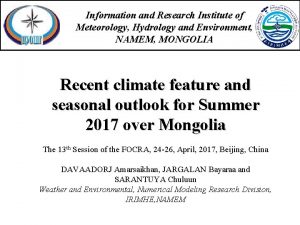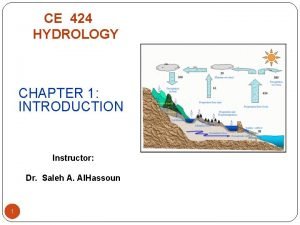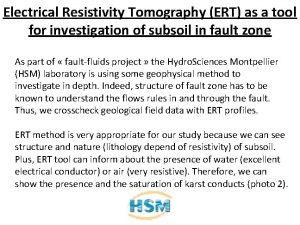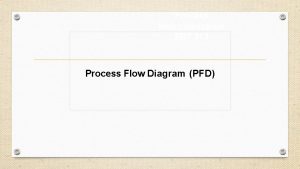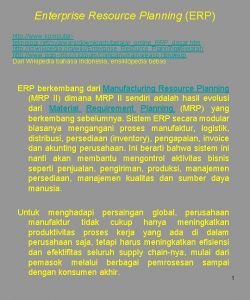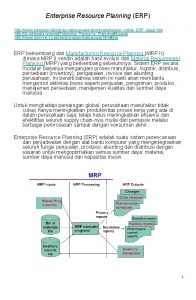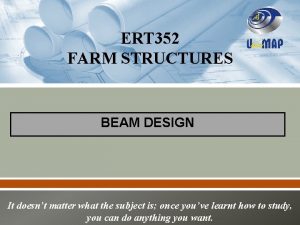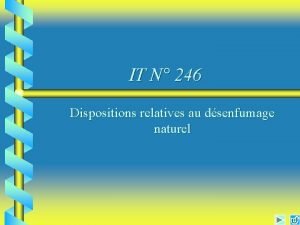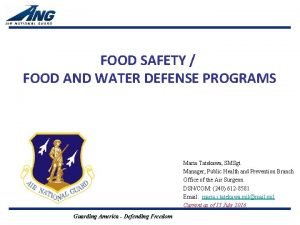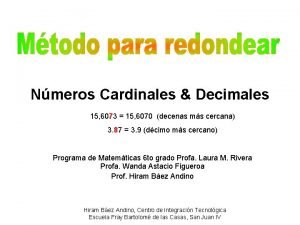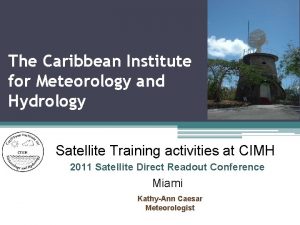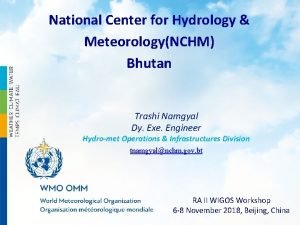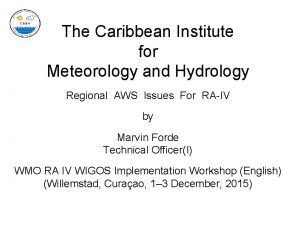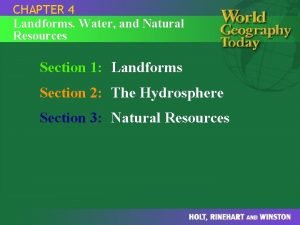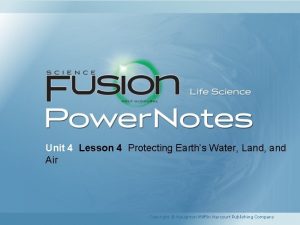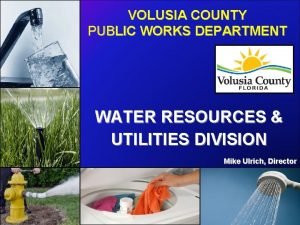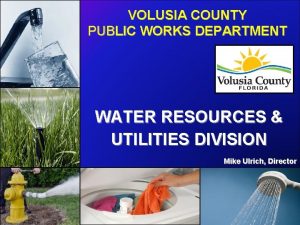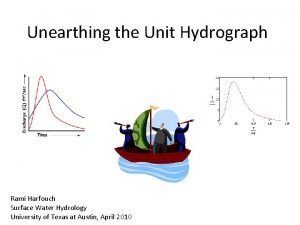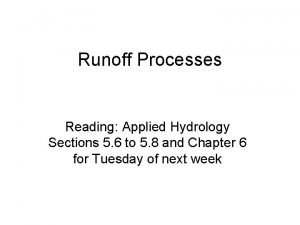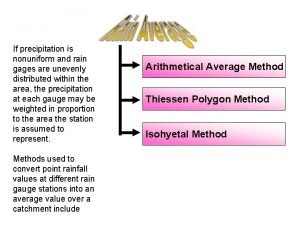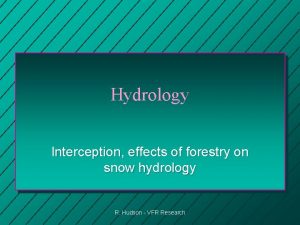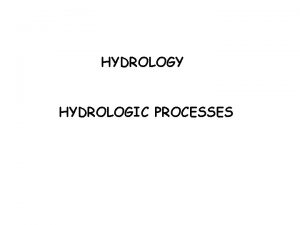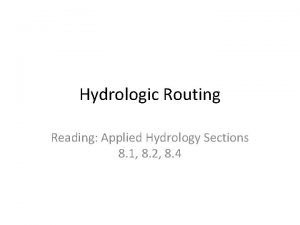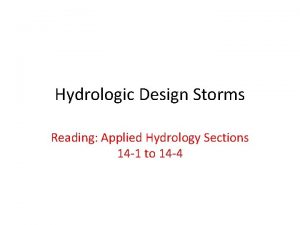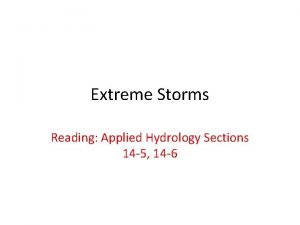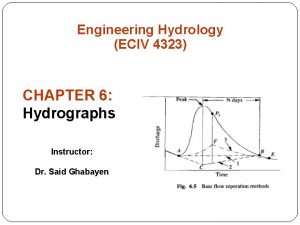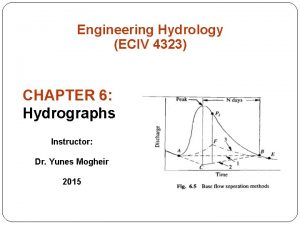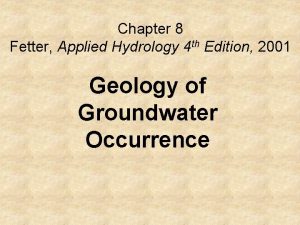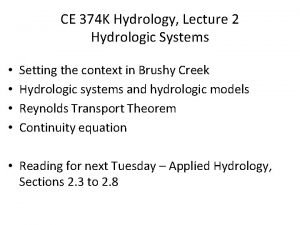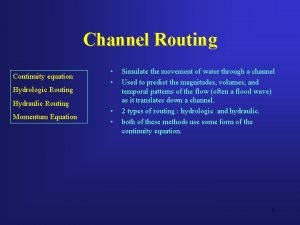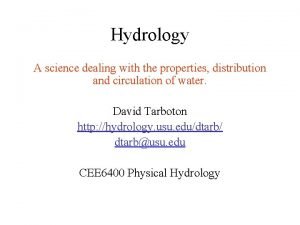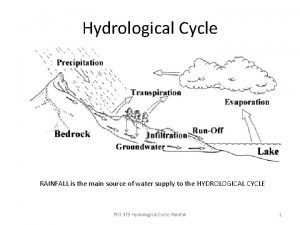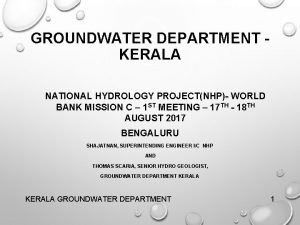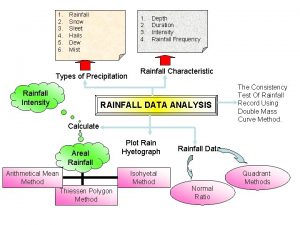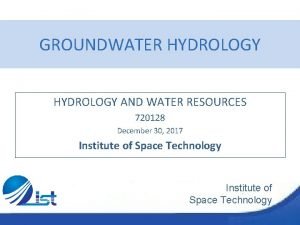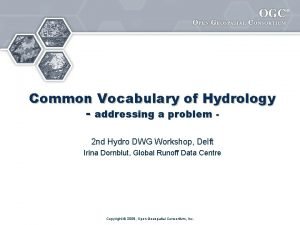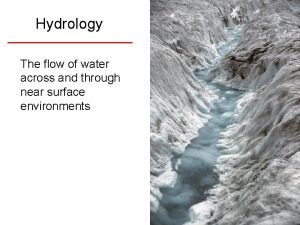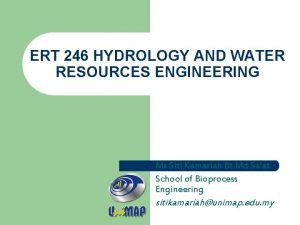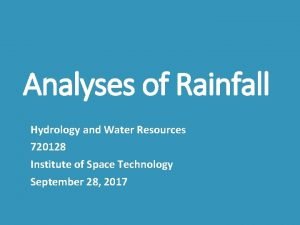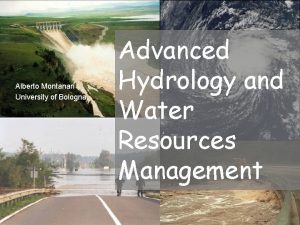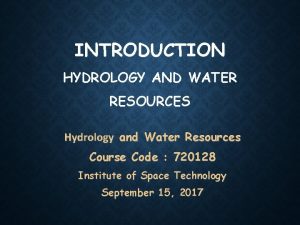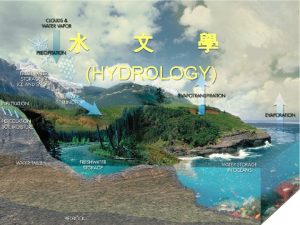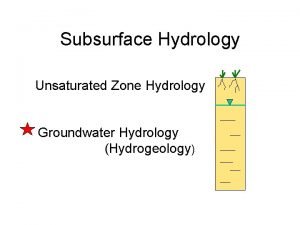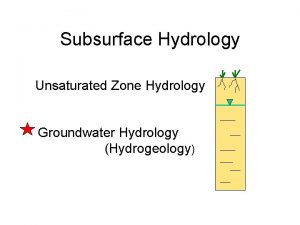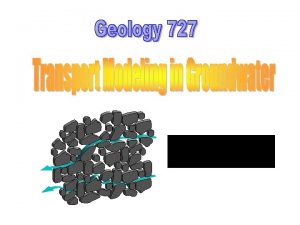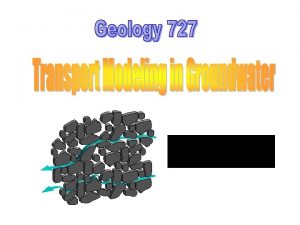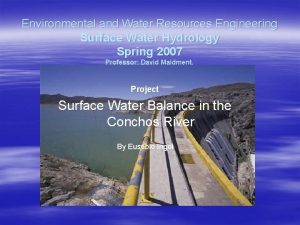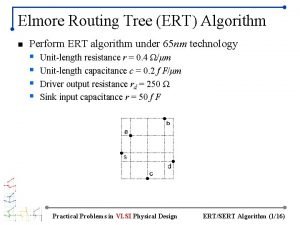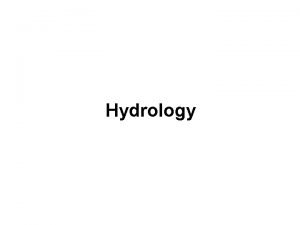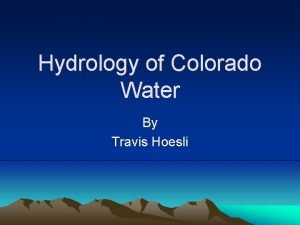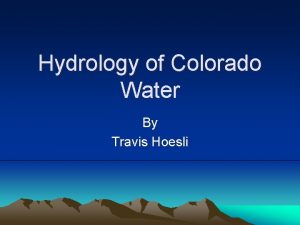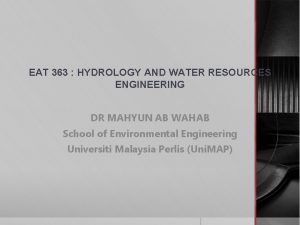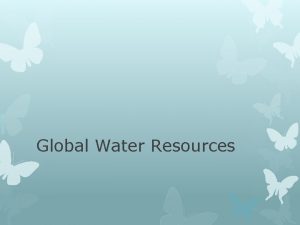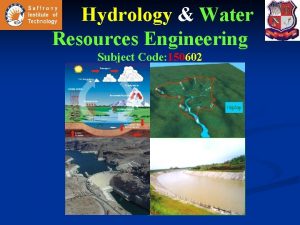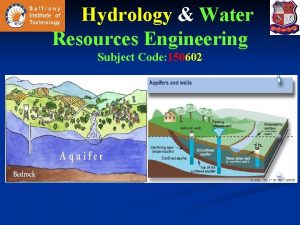ERT 246 HYDROLOGY AND WATER RESOURCES ENGINEERING Ms


































































- Slides: 66

ERT 246 HYDROLOGY AND WATER RESOURCES ENGINEERING Ms Siti Kamariah Bt Md Sa’at School of Bioprocess Engineering sitikamariah@unimap. edu. my 1

2 Text Book l Bedient B. P; Huber W. C and Vieux B. E, . (2008) Hydrology & Floodplain Analysis, 4 th Ed. Prentice-Hall, Inc, Upper Saddle River, NJ 07458

3 Reference Books l l l Subramaya K. (2008), Engineering Hydrology, 3 rd Ed. Mc. Graw Hill, New York, N. Y DID. (2000), Urban Stormwater Management Manual for Malaysia, DID, Malaysia V. T. Chow, D. R. Maidment and L. W. Mays (1988, ) Applied Hydrology, Mc. Graw-Hill

4 Course Objectives At the end of the course, students are expected to be: l 1. EXPLAIN and DISCUSS components of hydrologic cycle. l 2. Ability to DEMONSTRATE use of , ASSESS, and PERFORM, techniques of hydrologic analyses. l 3. ANALYZE and ASSESS hydrologic data for engineering design and management

INTRODUCTION 5

6 What is hydrology l l From Greek word “hudor” means water and “logy” means research. The science dealing with all aspects of the waters of the Earth. Water is essential for all living things. It also participates in the physical and geochemical evolution of most nonliving matter on Earth Its adequate supply is a key factor for urban, agricultural, and industrial development

7 What is hydrology l l l Deals with occurence, circulation, storange and distribution of surface and ground water on earth Relates to water quality and quantity Hydrologic cycle and process Water resources management To solve human problem related to water such as flood, water supply

8 Hydrology and Water Resources Engineering

Hydrology and Water Resources Engineering 9

10 History of Hydrology - 1800 s l l l l Chezy Channel Formula in the 1780 s Open channel flow experiments - 1800 s US Army Corps of Eng established (1802) Darcy and Dupuit laws of ground water - 1850 s USGS first measured Miss River flow in 1888 Manning’s Eqn - Open Channel Flow - 1889 U. S. Weather Bureau 1891 (NWS) Major Hurricane at Galveston - 1900 (8000 dead)

11 History of Hydrology - 1900 s l Early 1900 s saw great expansion of water supply and flood control dams in the western U. S. - in response to Dust Bowl and the Great Depression of the 1920 s & 30 s l U. S. Dept of Agriculture began many hydrologic studies l Sherman UH and Horton infiltration theory - mid 1930 s l U. S. Army Corps of Engineers (1930 s) - large projects l Major Hurricane at Florida - over 2000 deaths l Penman (1948) - complete theory of evaporation

12 Important of water l l l The most important resources after oxygen. Minimum requirement for human= 1. 5 L/d Plants also need water for photosynthesis and nutrient transport Human civilization such as Nile River, Hwang Ho River, Klang River Water related problem

13 Problems in Hydrology l l l l Extreme weather and rainfall variation Streamflow and major flood devastation River routing and hydraulic conditions Overall water supply - local and global scales Flow and hydraulics in pipes, streams and channels Flood control and drought measures Watershed management for urban development

14 Total water in the world = 1. 36 x 1018 m 3

15 What percent of the Earth’s total volume of water is stored in the atmosphere? 0. 001% l Water vapor l Clouds (water vapor condensed on particulate) l

16

17

18

19

20 Major Hydrologic Cycle Processes l l l Precipitation Evaporation or ET (loss to atmosphere) Infiltration (loss to subsurface soils) Overland flow (sheet flow toward nearest stream) Streamflow Ground water flow and well

21 The Hydrologic Cycle

22 Atmosphere

23

24 What two processes change liquid water into vapor that can ascend into the atmosphere? • Evaporation 90% • Transpiration What percent of the water in the atmosphere comes from evaporation? 10%

25 Evaporation • The process by which liquid water is transformed into a gaseous state • Evaporation into a gas ceases when the gas reaches saturation

26 Evaporation v. Precipitation l l l About equal on a global scale Evaporation more prevalent over the oceans than precipitation Over land, precipitation exceeds evaporation Most water evaporated from the oceans falls back into the ocean as precipitation 10% of water evaporated from the ocean is transported over land falls as precipitation Once evaporated, a water molecule spends ~ 10 days airborne

27 Transpiration The process of water loss from plants through stomata. (Stomata are small openings found on the underside of leaves that are connected to vascular plant tissues. ) • passive process that depends on: ~humidity of the atmosphere ~the moisture content of the soil • only 1 % of the water transpired used for growth • transports nutrients from the soil into the roots and carries them to the various cells of the plant • keeps tissues from becoming overheated

28 Precipitation l The vapor that accumulates or freezes on condensation nuclei is acted on by gravity and falls to Earth’s surface. rain, freezing rain, sleet, snow, or hail primary connection in the water cycle that provides for the delivery of atmospheric water to the Earth

29 Meteorological factors affecting surface Runoff l Type of precipitation l l l l Rainfall intensity Rainfall amount Rainfall duration Distribution of rainfall over the drainage basin Direction of storm movement Precipitation that occurred earlier and resulting soil moisture Meteorological conditions that affect evapotranspiration

30 Physical characteristics affecting surface runoff l l l l l Land use Vegetation Soil type Drainage area Basin shape Elevation Topography, especially the slope of the land Drainage network patterns Ponds, lakes, reservoirs, sinks, etc. in the basin, which prevent or delay runoff from continuing downstream

31 Human factors affecting surface runoff l l Urbanization -- more impervious surfaces reduce infiltration and accelerate water motion Removal of vegetation and soil -- surface grading, artificial drainage networks increases volume of runoff and shortens runoff time to streams from rainfall and snowmelt

32 Most runoff… l Drains to a creek – To a stream l To a river – To an ocean – Rarely runoff drains to a closed lake – May be diverted for human uses

33 Groundwater begins as INFILTRATION Precipitation falls and infiltrates into the subsurface soil and rock • Can remain in shallow soil layer • Might seep into a stream bank • May infiltrate deeper, recharging an aquifer • May travel long distances • May stay in storage as ground water

34 How much ground water? l Ground water occurs only close to the surface (a few miles down) – Density of soil/rock increases with depth – The weight of the rocks above condense the rocks below and squeeze out the open pore spaces deeper in the Earth

35

36 Watershed l A basin, drainage or catchment area that is the land area that contributes runoff to an outlet point Watershed boundary Outlet point

37 Watersheds l l We all live in a watershed! Area of land from which all water drains, running downhill, to a shared destination - a river, pond, stream, lake, or estuary

38 Watersheds l l Area of land that drains to a single outlet and is separated from other watersheds by a drainage divide. Rainfall that falls in a watershed will generate runoff to that watershed outlet. Topographic elevation is used to define a Watershed boundary (land survey or LIDAR) Scale is a big issue for analysis

39 Functions l l l Captures precipitation – its characteristics influence how much is captured Stores water once it infiltrates into soil (important to plants) Slowly releases water into streams, rivers, oceans

40

41 Why are watersheds important? l l Activities within a watershed impact runoff and water quality of water leaving the watershed Must manage at a watershed level rather than other boundaries to attain goals related to runoff and water quality

42 Watershed Characteristics Divide Reservoir q Size 1 mile q Slope Natural stream Urban q Shape q Soil type q Storage capacity Concrete channel

43 Watershed Shapes • Important hydrologic characteristic • Elongated Shape • Concentrated Shape • Affects Timing and Peak Flow • Determined by geo - morphology of stream

44

45 Measurement and Unit l 3 types of measurement – Depth l l – Volume l l – mm, cm, m, inch, ft Total rainfall, river depth, evaporation cm 3, liter, ft 3, meter hectare, km 3 Rainfall volume in tank, water requirement, ocean volume Flowrate l l L/s, L/min, m 3/s Stream flowrate, flow in pipe

46 Units l l l Rainfall volume is normally measured in inches or cm Rainfall rate or intensity in inches/hr or cm/hr Infiltration is measured in inches/hr or cm/hr Evaporation is measured in inches or in/hr (cm/hr) Streamflow is measured in cfs or m 3/s Ground water flows are measured as ft 3/day or m 3/day

47 Hydrological Data l Meteorological Data – – l Rainfall data – l DID Streamflow record – l Temperature, relative humidity, moisture, wind speed, sun Data can be obtained fom JMM DID Water quality record – JAS, ASMA

48 Water Balance/Budget d. S/dt = I – O Where d. S/dt = change in storage per time I = inflow O = outflow l

49 Water Balance/Budget Input-Output = Change in storage l P-R-G-E-T = ∆S Where P = precipitation R = surface runoff G = ground water flow E = evaporation T = transpiration ∆S = change in storage l

50 Example 1 l A catchment received inflow and outflow in 10 and 15 m 3/s for 24 hours. How much volume changes?

51 Example 2 l A catchment received annual rainfall 2500 mm with 1400 mm/year evapotranspiration. With losses to groundwater is 250 mm per year and area of the catchment 70 km 2, calculate volume of water flowing out from the catchment. Assume there is no changes in storage.

52 Measurement and Unit l 3 types of measurement – Depth l l – Volume l l – mm, cm, m, inch, ft Total rainfall, river depth, evaporation cm 3, liter, ft 3, meter hectare, km 3 Rainfall volume in tank, water requirement, ocean volume Flowrate l l L/s, L/min, m 3/s Stream flowrate, flow in pipe

53 Units l l l Rainfall volume is normally measured in inches or cm Rainfall rate or intensity in inches/hr or cm/hr Infiltration is measured in inches/hr or cm/hr Evaporation is measured in inches or in/hr (cm/hr) Streamflow is measured in cfs or m 3/s Ground water flows are measured as ft 3/day or m 3/day

54 Units of Flow l l After measures of volume, measures of flow are most important in hydrology. CFS: – – The important measures of flow are Cubic foot per second (CFS) (which is used for streams and rivers). A small stream might be 1 -10 CFS a large river 100, 000 or more CFS.

55 Units of Flow l GPM – l Gallons per minute (GPM) is the typical unit for production from wells. A typical well will product 20 -100 GPM while very large wells will produce 2000 or more GPM. MGD: – Millions of gallons per day (MGD) is a typical unit for water treatment plants and sewage treatment plants. A small plant might be 1 -10 MGD while a large plant might be 100 -200 MGD.

56 Units of Flow l CMS: – Cubic meters per second is not as common in the U. S. but is common everywhere else.

57 How thirsty are you? l l l The average person needs something like 1 -2 quarts of water a day, although consumption could be much higher in hot arid areas. Or during fraternity parties (of beer anyway)… Gallons are therefore good units for individual water consumption.

58 How thirsty is your toilet? l l The typical consumption of water in residential settings is closer to 100 gallons per day person. Thus gallons is not a very convenient unit for measuring municipal water use.

59 How thirsty is your cotton crop? l Agriculture consumes far more water than municipal uses, so gallons are rarely used for measuring agricultural water use.

60 Acre Feet l l Rather the acre foot is the common measure for large quantities of water and is approximately 325, 851 gallons. This is the volume of water that will cover one acre of land to the depth of one foot. It is equal to 43, 560 cubic feet of water.

61 Other units l l l Units of water velocity are feet/sec or meters/sec and Units of stage height are feet or meters. There also units of concentration, typically parts per million PPM or parts per billion PPB.

62 CONVERSION FACTORS Distance: l 1 meter = 3. 281 feet. l 1 mile = 5280 feet l 1 kilometer = 1, 000 meters = 1, 000 mm. Volume l 1 cubic meter = 264. 2 gallons. l 1 cubic foot = 7. 48 gallons, 28. 32 liters. l 1 liter =. 2642 gallons. l 1 acre foot = 325, 851 gallons.

63 CONVERSION FACTORS Weight: l 1 kg = 2. 205 pounds. l 1 cubic decimeter = 1 kg. l 1 gallon = 8. 33 pounds l 1 cubic foot = 62. 31 pounds Velocity: l 1 meter/sec = 2. 237 mi/hr. l 1 foot/sec = 1. 097 km/hr. Other factors. l 1 inch of run-off per hour from one acre = 1 cubic foot per second of flow.

64 CONVERSION FACTORS Flow l 1 cubic meter per second = 35. 32 cubic feet per second l 1 cubic foot per second for 1 day = 1. 98 acre feet. l Conversion factors metric to U. S. Customary l 1 hectare = 2. 471 acres, 10, 000 square meters. l 1 acre = 43, 560 square feet.

65 Hydrological Data l Meteorological Data – – l Rainfall data – l DID Streamflow record – l Temperature, relative humidity, moisture, wind speed, sun Data can be obtained fom JMM DID Water quality record – JAS, ASMA

Thank You 66
 Water and water and water water
Water and water and water water Meteorology hydrology and water management
Meteorology hydrology and water management Qg 424
Qg 424 Pt
Pt Ert controller
Ert controller Ert tool
Ert tool Ert diagram
Ert diagram Ert erp definition
Ert erp definition Ert erp definition
Ert erp definition Ert 1 programa
Ert 1 programa Ert products malaysia
Ert products malaysia Wl2/8
Wl2/8 En un zoológico hay 246 aves
En un zoológico hay 246 aves It 246
It 246 Afman 10-246
Afman 10-246 Cs 246 stanford
Cs 246 stanford Place value of 246
Place value of 246 Cs 246
Cs 246 246 regel diabetes
246 regel diabetes Ds p van veen
Ds p van veen 15 cienmilésimos en decimales
15 cienmilésimos en decimales Cs246 stanford
Cs246 stanford Estimate word problems
Estimate word problems Mining massive datasets
Mining massive datasets Operation transformation process
Operation transformation process Example of fixed resources
Example of fixed resources Caribbean weather satellite
Caribbean weather satellite National center for hydrology and meteorology
National center for hydrology and meteorology Caribbean institute for meteorology and hydrology
Caribbean institute for meteorology and hydrology Renewable resources vs nonrenewable resources
Renewable resources vs nonrenewable resources Chapter 4 landforms water and natural resources
Chapter 4 landforms water and natural resources Air and water resources lesson 4
Air and water resources lesson 4 Volusia county utilities
Volusia county utilities Volusia county utilities
Volusia county utilities Applied hydrology
Applied hydrology Scs method
Scs method Quadrant method hydrology
Quadrant method hydrology Hydrology test answers
Hydrology test answers Drh meaning in hydrology
Drh meaning in hydrology Interception hydrology
Interception hydrology Applied hydrology
Applied hydrology Hydrograph
Hydrograph Applied hydrology
Applied hydrology Applied hydrology
Applied hydrology Drh in hydrology
Drh in hydrology Drh in hydrology
Drh in hydrology Applied hydrology
Applied hydrology Continuity equation hydrology
Continuity equation hydrology Reynolds transport theorem
Reynolds transport theorem Bernoulli's equation application
Bernoulli's equation application Branches of hydrology
Branches of hydrology Hydrologic continuity equation
Hydrologic continuity equation Continuity equation hydrology
Continuity equation hydrology Hydrology lecture
Hydrology lecture Hydrology is science which deals with
Hydrology is science which deals with Quadrant method hydrology
Quadrant method hydrology Hydrology department kerala
Hydrology department kerala Quadrant method hydrology
Quadrant method hydrology Design storm in hydrology
Design storm in hydrology Groundwater hydrology
Groundwater hydrology Hydrology
Hydrology International glossary of hydrology
International glossary of hydrology Return flow in hydrology
Return flow in hydrology What is hydrology
What is hydrology Precipitation
Precipitation Dad curve hydrology
Dad curve hydrology Advanced hydrology
Advanced hydrology

